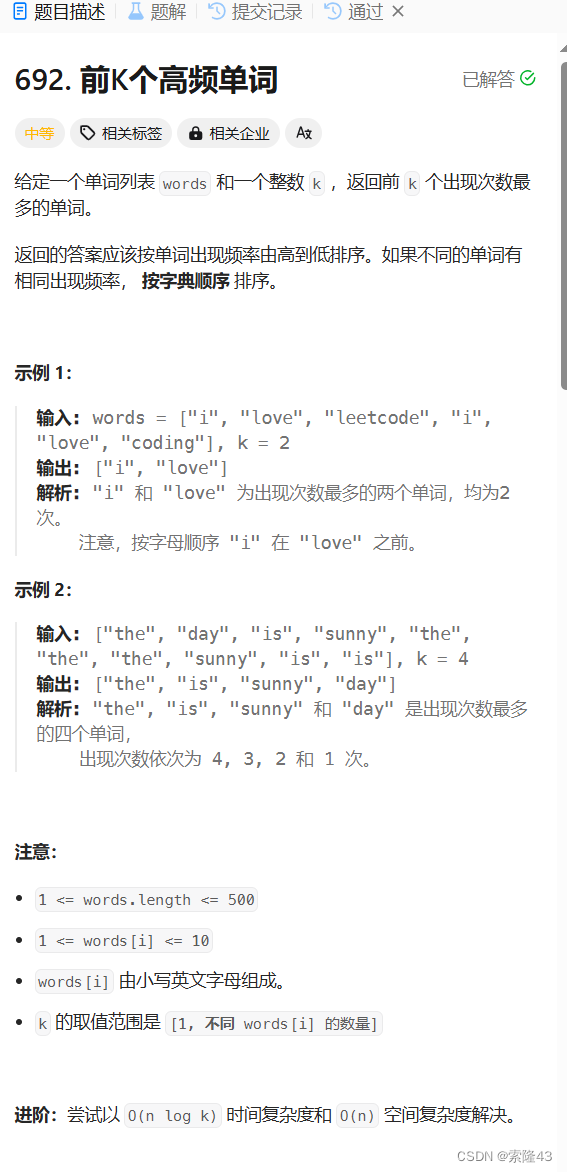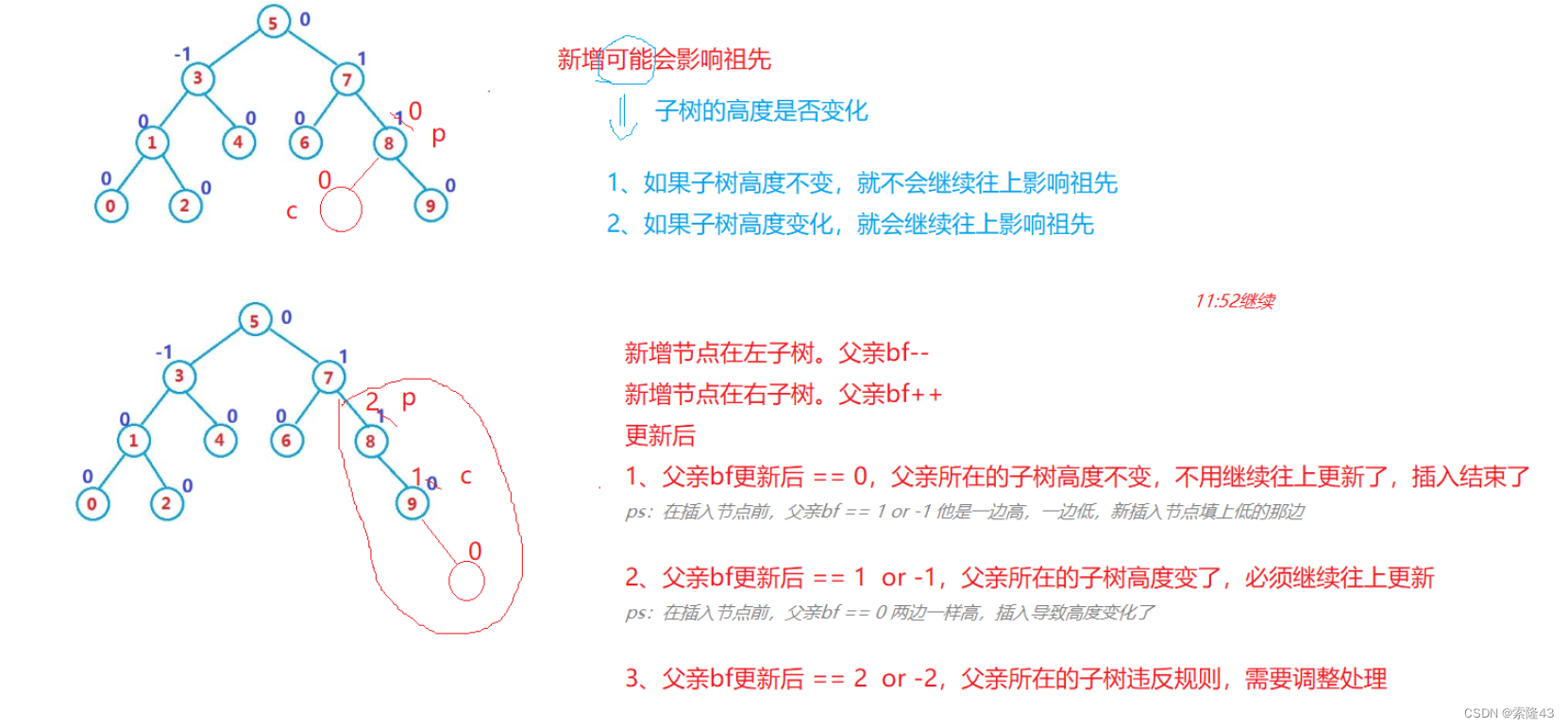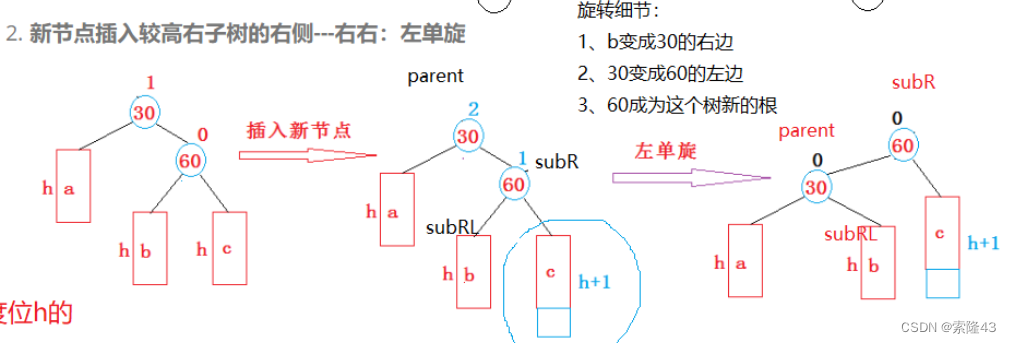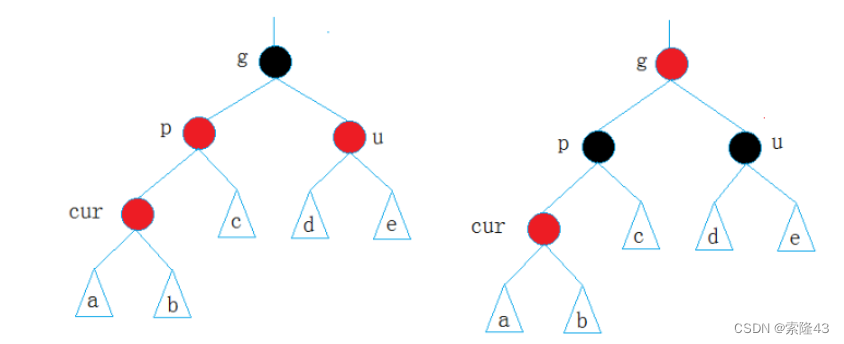C++map和set
- 1.set
- 1.1set的使用
- 1.1.1 set的模板参数列表
- 1.1.2set的构造
- 1.1.3set的迭代器
- 1.1.4 set的容量
- 1.1.5 set修改操作
- 1.1.6 set的具体使用例子
- 2.map
- 2.1map的使用
- 2.1.1map的模板参数列表
- 2.1.2map的构造
- 2.1.3map的迭代器
- 2.1.4 map的容量与元素访问
- 2.1.5 map中元素的修改
- 2.1.6map的具体使用例子
- 3.multiset
- 3.1 multiset的具体使用
- 4.multimap
- 5.笔试题
- 6.AVL树
- 6.1AVL树的实现
- 6.1.1AVL树节点的定义
- 6.1.2AVL树的插入
- 6.1.4AVL树的旋转
- 6.1.5AVL树的验证
- 7.红黑树
- 7.1红黑树的性质
- 7.2红黑树的实现
- 7.2.1红黑树节点的定义
- 7.2.2红黑树的插入操作
- 7.2.3红黑树的验证
- 8.红黑树与AVL树的比较
- 9.map和set模拟实现
- 9.1改造红黑树
- 9.2map模拟实现
- 9.3set的模拟实现
1.set
C++set官方文档
- set是按照一定次序存储元素的容器
- 在set中,元素的value也标识它(value就是key,类型为T),并且每个value必须是唯一的。set中的元素不能在容器中修改(元素总是const),但是可以从容器中插入或删除它们。
- 在内部,set中的元素总是按照其内部比较对象(类型比较)所指示的特定严格弱排序准则进行排序。
- set容器通过key访问单个元素的速度通常比unordered_set容器慢,但它们允许根据顺序对子集进行直接迭代。
- set在底层是用二叉搜索树(红黑树)实现的。
注意:
- 与map/multimap不同,map/multimap中存储的是真正的键值对<key, value>,set中只放value,但在底层实际存放的是由<value, value>构成的键值对。
- set中插入元素时,只需要插入value即可,不需要构造键值对。
- set中的元素不可以重复(因此可以使用set进行去重)。
- 使用set的迭代器遍历set中的元素,可以得到有序序列
- set中的元素默认按照小于来比较
- set中查找某个元素,时间复杂度为: l o g 2 n log_2 n log2n
- set中的元素不允许修改
- set中的底层使用二叉搜索树(红黑树)来实现。
1.1set的使用
1.1.1 set的模板参数列表

T: set中存放元素的类型,实际在底层存储<value, value>的键值对。
Compare:set中元素默认按照小于来比较
Alloc:set中元素空间的管理方式,使用STL提供的空间配置器管理
1.1.2set的构造
| 函数声明 | 功能介绍 |
|---|---|
| set (const Compare& comp = Compare(), const Allocator& = Allocator() ); | 构造空的set |
| set (InputIterator first, InputIterator last, const Compare& comp = Compare(), const Allocator& = Allocator() ); | 用[first, last)区间中的元素构造set |
| set ( const set<Key,Compare,Allocator>& x); | set的拷贝构造 |
1.1.3set的迭代器
| 函数声明 | 功能介绍 |
|---|---|
| iterator begin() | 返回set中起始位置元素的迭代器 |
| iterator end() | 返回set中最后一个元素后面的迭代器 |
| const_iterator cbegin() const | 返回set中起始位置元素的const迭代器 |
| const_iterator cend() const | 返回set中最后一个元素后面的const迭代器 |
| reverse_iterator rbegin() | 返回set第一个元素的反向迭代器,即end |
| reverse_iterator rend() | 返回set最后一个元素下一个位置的反向迭代器,即begin |
| const_reverse_iterator crbegin() const | 返回set第一个元素的反向const迭代器,即cend |
| const_reverse_iterator crend() const | 返回set最后一个元素下一个位置的反向const迭代器,即cbegin |
1.1.4 set的容量
| 函数声明 | 功能介绍 |
|---|---|
| bool empty ( ) const | 检测set是否为空,空返回true,否则返回false |
| size_type size() const | 返回set中有效元素的个数 |
1.1.5 set修改操作
| 函数声明 | 功能介绍 |
|---|---|
| pair<iterator,bool> insert ( const value_type& x ) | 在set中插入元素x,实际插入的是<x, x>构成的键值对,如果插入成功,返回<该元素在set中的位置,true>,如果插入失败,说明x在set中已经存在,返回<x在set中的位置,false> |
| void erase ( iterator position ) | 删除set中position位置上的元素 |
| size_type erase ( const key_type& x ) | 删除set中值为x的元素,返回删除的元素的个数 |
| void erase ( iterator first, iterator last ) | 删除set中[first, last)区间中的元素 |
| void swap ( set<Key,Compare,Allocator>& st ); | 交换set中的元素 |
| void clear ( ) | 将set中的元素清空 |
| iterator find ( const key_type& x ) const | 返回set中值为x的元素的位置 |
| size_type count ( const key_type& x ) const | 返回set中值为x的元素的个数 |
1.1.6 set的具体使用例子
#include<iostream>
#include<set>
using namespace std;
void TestSet()
{//用数组arr中的元素构造setint arr[] = { 1, 3, 5, 7, 9, 2, 4, 6, 8, 0, 1, 3, 5, 7, 9, 2, 4, 6, 8, 0 };set<int> s(arr, arr + sizeof(arr) / sizeof(arr[0]));cout << s.size() << endl;//正向打印set中的元素,从打印结果中可以看出:set可以去重for (auto& e : s){cout << e << " ";}cout << endl;//使用迭代器逆向打印set中的元素for (auto it = s.begin();it != s.end();it++){cout << *it << endl;}cout << endl;//set中值为3的元素出现了几次cout << s.count(3) << endl;
}
2.map
C++map的官方文档
- map是关联容器,它按照特定的次序(按照key来比较)存储由键值key和值value组合而成的元素。
- 在map中,键值key通常用于排序和惟一地标识元素,而值value中存储与此键值key关联的内容。键值key和value的类型可能不同,并且在map的内部,key与value通过成员类型value_type绑定在一起,为其取别名称为pair:
typedef pair<const key, T> value_type; - 在内部,map中的元素总是按照键值key进行比较排序的。
- map中通过键值访问单个元素的速度通常比unordered_map容器慢,但map允许根据顺序对元素进行直接迭代(即对map中的元素进行迭代时,可以得到一个有序的序列)。
- map支持下标访问符,即在[]中放入key,就可以找到与key对应的value。
- map通常被实现为二叉搜索树(平衡二叉搜索树(红黑树))。
2.1map的使用
2.1.1map的模板参数列表

key: 键值对中key的类型
T: 键值对中value的类型
Compare: 比较器的类型,map中的元素是按照key来比较的,缺省情况下按照小于来比较,一般情况下(内置类型元素)该参数不需要传递,如果无法比较时(自定义类型),需要用户自己显式传递比较规则(一般情况下按照函数指针或者仿函数来传递)
Alloc:通过空间配置器来申请底层空间,不需要用户传递,除非用户不想使用标准库提供的空间配置器
2.1.2map的构造
| 函数声明 | 功能介绍 |
|---|---|
| map() | 构造一个空的map |
2.1.3map的迭代器
| 函数声明 | 功能介绍 |
|---|---|
| begin() 和 end() | begin:首元素的位置,end最后一个元素的下一个位置 |
| cbegin()和cend() | 与begin和end意义相同,但cbegin和cend所指向的元素不能修改 |
| rbegin()和rend() | 反向迭代器,rbegin在end位置,rend在begin位置,其++和–操作与begin和end操作移动相反 |
| crbegin()和crend() | 与rbegin和rend位置相同,操作相同,但crbegin和crend所指向的元素不能修改 |
2.1.4 map的容量与元素访问
| 函数声明 | 功能介绍 |
|---|---|
| bool empty ( ) const | 检测map中的元素是否为空,是返回true,否则返回false |
| size_type size() const | 返回map中有效元素的个数 |
| mapped_type& operator[] (const key_type& k) | 返回去key对应的value |
当key不存在时,operator[]用默认value与key构造键值对然后插入
2.1.5 map中元素的修改
| 函数声明 | 功能介绍 |
|---|---|
| pair<iterator,bool> insert ( const value_type& x ) | 在map中插入键值对x,注意x是一个键值对,返回值也是键值对:iterator代表新插入元素的位置,bool代表释放插入成功 |
| void erase ( iterator position ) | 删除position位置上的元素 |
| void erase ( const key_type& x ) | 删除键值为x的元素 |
| void erase ( iterator first, iterator last ) | 删除[first, last)区间中的元素 |
| void swap ( map<Key,T,Compare,Allocator>& mp ) | 交换两个map中的元素 |
| void clear ( ) | 将map中的元素清空 |
| iterator find ( const key_type& x ) | 在map中寻找key为x的元素,找到返回该元素的位置的迭代器,否则返回end位置的迭代器 |
| const_iterator find ( const key_type& x ) const | 在map中寻找key为x的元素,找到返回该元素的位置的const迭代器,否则返回cend位置的迭代器 |
| size_type count ( const key_type& x ) const | 返回key为x的键值在map中的个数,注意map中key是唯一的,因此该函数的返回值要么为0,要么为1,因此也可以用该函数来检测一个key是否在map中 |
2.1.6map的具体使用例子
#include<string>
#include<map>
#include<iostream>
void TestMap()
{map<string, string> m;//向map中插入元素的方式://将键值对<"peach","桃子">插入map中,用pair直接来构造键值对m.insert(pair<string, string>("peach", "桃子"));//将键值对<"peach","桃子">插入map中,用make_pair函数来构造键值对m.insert(make_pair("peach", "桃子"));//借用operator[]向map中插入元素
/*operator[]的原理是:用<key, T()>构造一个键值对,然后调用insert()函数将该键值对插入到map中如果key已经存在,插入失败,insert函数返回该key所在位置的迭代器如果key不存在,插入成功,insert函数返回新插入元素所在位置的迭代器operator[]函数最后将insert返回值键值对中的value返回*/// 将<"apple", "">插入map中,插入成功,返回value的引用,将“苹果”赋值给该引用结果,m["apple"] = "苹果";//用迭代器去遍历map中的元素,可以得到一个按照key排序的序列for (auto& e : m){cout << e.first << "->" << e.second << endl;}cout << endl;//map中的键值对key一定是唯一的,如果key存在将插入失败auto ret = m.insert(make_pair("peach", "桃色"));if (ret.second){cout << "<peach, 桃色>不在map中, 已经插入" << endl;}else{cout << "键值为peach的元素已经存在:" << ret.first->first << "--->"<< ret.first->second << " 插入失败" << endl;}//删除key为“apple”的元素m.erase("apple");if (1 == m.count("apple")){cout << "apple还在" << endl;}else{cout << "apple被吃了" << endl;}
}
总结:
- map中的的元素是键值对
- map中的key是唯一的,并且不能修改
- 默认按照小于的方式对key进行比较
- map中的元素如果用迭代器去遍历,可以得到一个有序的序列
- map的底层为平衡搜索树(红黑树),查找效率比较高 O ( l o g 2 N ) O(log_2 N) O(log2N)
- 支持[]操作符,operator[]中实际进行插入查找。
3.multiset
C++multiset官方文档
- multiset是按照特定顺序存储元素的容器,其中元素是可以重复的。
- 在multiset中,元素的value也会识别它(因为multiset中本身存储的就是<value, value>组成的键值对,因此value本身就是key,key就是value,类型为T). multiset元素的值不能在容器中进行修改(因为元素总是const的),但可以从容器中插入或删除。
- 在内部,multiset中的元素总是按照其内部比较规则(类型比较)所指示的特定严格弱排序准则进行排序。
- multiset容器通过key访问单个元素的速度通常比unordered_multiset容器慢,但当使用迭代器遍历时会得到一个有序序列。
- multiset底层结构为二叉搜索树(红黑树)。
注意:
- multiset中再底层中存储的是<value, value>的键值对
- mtltiset的插入接口中只需要插入即可
- 与set的区别是,multiset中的元素可以重复,set是中value是唯一的
- 使用迭代器对multiset中的元素进行遍历,可以得到有序的序列
- multiset中的元素不能修改
- 在multiset中找某个元素,时间复杂度为 O ( l o g 2 N ) O(log_2 N) O(log2N)
- multiset的作用:可以对元素进行排序
3.1 multiset的具体使用
#include<set>
void TestSet()
{int arr[]= { 2, 1, 3, 9, 6, 0, 5, 8, 4, 7 };//注意multiset在底层实际储存的是<int,int>的键值对multiset<int> s(arr, arr + sizeof(arr) / sizeof(arr[0]));for (auto& e : s){cout << e << "";}cout << endl;
}
4.multimap
C++multimap的官方文档
- Multimaps是关联式容器,它按照特定的顺序,存储由key和value映射成的键值对<key, value>,其中多个键值对之间的key是可以重复的。
- 在multimap中,通常按照key排序和惟一地标识元素,而映射的value存储与key关联的内容。key和value的类型可能不同,通过multimap内部的成员类型value_type组合在一起,
value_type是组合key和value的键值对:
typedef pair<const Key, T> value_type; - 在内部,multimap中的元素总是通过其内部比较对象,按照指定的特定严格弱排序标准对key进行排序的。
- multimap通过key访问单个元素的速度通常比unordered_multimap容器慢,但是使用迭代器直接遍历multimap中的元素可以得到关于key有序的序列。
- multimap在底层用二叉搜索树(红黑树)来实现。
注意:multimap和map的唯一不同就是:map中的key是唯一的,而multimap中key是可以重复的。
5.笔试题
前K个高频单词

class Solution {
public:struct kvCom{bool operator()(const pair<string,int>& kv1,const pair<string,int>& kv2){return kv1.second > kv2.second || (kv1.first < kv2.first && kv1.second == kv2.second);}};vector<string> topKFrequent(vector<string>& words, int k){map<string,int> mp;for(auto& e:words){mp[e]++;}vector<pair<string,int>> sortV(mp.begin(),mp.end());sort(sortV.begin(),sortV.end(),kvCom());vector<string> v;for(size_t i=0;i<k;i++){v.push_back(sortV[i].first);}return v;}
};
两个数组的交集

class Solution {
public:vector<int> intersection(vector<int>& nums1, vector<int>& nums2){vector<int> v;set<int> s1(nums1.begin(),nums1.end());set<int> s2(nums2.begin(),nums2.end());auto it1=s1.begin();auto it2=s2.begin();while(it1!=s1.end()&&it2!=s2.end()){if(*it1<*it2){it1++;}else if(*it1>*it2){it2++;}else{v.push_back(*it1);it1++;it2++;}}return v;}
};
6.AVL树
向二叉搜索树中插入新结点后,如果能保证每个结点的左右子树高度之差的绝对值不超过1
一棵AVL树或者是空树,或者是具有以下性质的二叉搜索树:
- 它的左右子树都是AVL树
- 左右子树高度之差(简称平衡因子)的绝对值不超过1(-1/0/1)
如果一棵二叉搜索树是高度平衡的,它就是AVL树。如果它有n个结点,其高度可保持在
O ( l o g 2 n ) O(log_2 n) O(log2n),搜索时间复杂度O( l o g 2 n log_2 n log2n)。
6.1AVL树的实现
6.1.1AVL树节点的定义
template<class K, class V>
struct AVLTreeNode
{pair<K, V> _kv;AVLTreeNode<K, V>* _left;AVLTreeNode<K, V>* _right;AVLTreeNode<K, V>* _parent;int _bf; // balance factorAVLTreeNode(const pair<K, V>& kv):_kv(kv), _left(nullptr), _right(nullptr), _parent(nullptr), _bf(0){}
};
6.1.2AVL树的插入

分两步:
- 按照二叉搜索树的方式插入新节点
- 调整节点的平衡因子
bool Insert(const pair<K, V>& kv)
{if (_root == nullptr){_root = new Node(kv);return true;}Node* parent = nullptr;Node* cur = _root;while (cur){if (cur->_kv.first < kv.first){parent = cur;cur = cur->_right;}else if (cur->_kv.first > kv.first){parent = cur;cur = cur->_left;}else{return false;}}cur = new Node(kv);if (parent->_kv.first < kv.first){parent->_right = cur;}else{parent->_left = cur;}cur->_parent = parent;// ... 控制平衡// 更新平衡因子while (parent){if (cur == parent->_left){parent->_bf--;}else // if (cur == parent->_right){parent->_bf++;}if (parent->_bf == 0){// 更新结束break;}else if (parent->_bf == 1 || parent->_bf == -1){// 继续往上更新cur = parent;parent = parent->_parent;}else if (parent->_bf == 2 || parent->_bf == -2){// 子树不平衡了,需要旋转if (parent->_bf == 2 && cur->_bf == 1){RotateL(parent);}else if (parent->_bf == -2 && cur->_bf == -1){RotateR(parent);}else if (parent->_bf == 2 && cur->_bf == -1){RotateRL(parent);}else if (parent->_bf == -2 && cur->_bf == 1){RotateLR(parent);}break;}else{assert(false);}}return true;
}
6.1.4AVL树的旋转
左单旋:

void RotateL(Node* parent)
{++_rotateCount;Node* cur = parent->_right;Node* curleft = cur->_left;parent->_right = curleft;if (curleft){curleft->_parent = parent;}cur->_left = parent;Node* ppnode = parent->_parent;parent->_parent = cur;if (parent == _root){_root = cur;cur->_parent = nullptr;}else{if (ppnode->_left == parent){ppnode->_left = cur;}else{ppnode->_right = cur;}cur->_parent = ppnode;}parent->_bf = cur->_bf = 0;
}
右单旋:

void RotateR(Node* parent)
{++_rotateCount;Node* cur = parent->_left;Node* curright = cur->_right;parent->_left = curright;if (curright)curright->_parent = parent;Node* ppnode = parent->_parent;cur->_right = parent;parent->_parent = cur;if (ppnode == nullptr){_root = cur;cur->_parent = nullptr;}else{if (ppnode->_left == parent){ppnode->_left = cur;}else{ppnode->_right = cur;}cur->_parent = ppnode;}parent->_bf = cur->_bf = 0;
}
右左单旋:

void RotateRL(Node* parent)
{Node* cur = parent->_right;Node* curleft = cur->_left;int bf = curleft->_bf;RotateR(parent->_right);RotateL(parent);if (bf == 0){cur->_bf = 0;curleft->_bf = 0;parent->_bf = 0;}else if (bf == 1){cur->_bf = 0;curleft->_bf = 0;parent->_bf = -1;}else if (bf == -1){cur->_bf = 1;curleft->_bf = 0;parent->_bf = 0;}else{assert(false);}
}
左右单旋:

void RotateLR(Node* parent)
{Node* cur = parent->_left;Node* curright = cur->_right;int bf = curright->_bf;RotateL(parent->_left);RotateR(parent);if (bf == 0){parent->_bf = 0;cur->_bf = 0;curright->_bf = 0;}else if (bf == -1){parent->_bf = 1;cur->_bf = 0;curright->_bf = 0;}else if (bf == 1){parent->_bf = 0;cur->_bf = -1;curright->_bf = 0;}
}
6.1.5AVL树的验证
- 验证其为二叉搜索树
如果中序遍历可得到一个有序的序列,就说明为二叉搜索树
void _InOrder(Node* root)
{if (root == nullptr){return;}_InOrder(root->_left);cout << root->_kv.first << " ";_InOrder(root->_right);
}
- 验证其为平衡树
每个节点子树高度差的绝对值不超过1(注意节点中如果没有平衡因子)
节点的平衡因子是否计算正确
int _Height(Node* root)
{if (root == nullptr){return 0;}int leftHeight = _Height(root->_left);int rightHeight = _Height(root->_right);return leftHeight < rightHeight ? leftHeight + 1 : rightHeight + 1;
}bool _IsBalance(Node* root)
{if (root == nullptr){return true;}int leftHeight = _Height(root->_left);int rightHeight = _Height(root->_right);if (rightHeight - leftHeight != root->_bf){cout << root->_kv.first << "平衡因子异常" << endl;return false;}return abs(rightHeight - leftHeight) < 2 && _IsBalance(root->_left) && _IsBalance(root->_right);
}
7.红黑树
红黑树,是一种二叉搜索树,但在每个结点上增加一个存储位表示结点的颜色,可以是Red或Black。 通过对任何一条从根到叶子的路径上各个结点着色方式的限制,红黑树确保没有一条路径会比其他路径长出两倍,因而是接近平衡的。
7.1红黑树的性质
- 每个结点不是红色就是黑色
- 根节点是黑色的
- 如果一个节点是红色的,则它的两个孩子结点是黑色的 (就是不能有连续的红色节点)
- 对于每个结点,从该结点到其所有后代叶结点的简单路径上,均 包含相同数目的黑色结点
- 每个叶子结点都是黑色的(此处的叶子结点指的是空结点)
7.2红黑树的实现
7.2.1红黑树节点的定义
enum Colour
{RED,BLACK
};template<class K, class V>
struct RBTreeNode
{RBTreeNode<K, V>* _left;RBTreeNode<K, V>* _right;RBTreeNode<K, V>* _parent;pair<K, V> _kv;Colour _col;RBTreeNode(const pair<K, V>& kv):_left(nullptr), _right(nullptr), _parent(nullptr), _kv(kv), _col(RED){}
};
7.2.2红黑树的插入操作
新增:插入红色节点
1.插入节点的父亲是黑色节点,那么直接就结束了,没有违反任何规则
2.插入节点的父亲是红色节点,那么存在连续的红色节点,违反规则三,需要处理
情况一:cur为红,p为红,g为黑,u存在且为红
解决方案:将p,u改为黑,g改为红,然后把g赋值给cur,继续向上调整

情况二:
1.cur为红,p为红,g为黑,u不存在
解决方案:p为g的左孩子,cur为p的左孩子,则进行右单旋,相反,p为g的右孩子,cur为p的右孩子,则进行左单旋,p变黑,g变红

2.cur为红,p为红,g为黑,u存在且为黑(中间态是由下层变上来的)

情况三:cur为红,p为红,g为黑,u不存在或者存在且为黑(其实就是g,p,c是折线,经过一次旋转后变成情况二)

bool Insert(const pair<K, V>& kv)
{if (_root == nullptr){_root = new Node(kv);_root->_col = BLACK;return true;}Node* parent = nullptr;Node* cur = _root;while (cur){if (cur->_kv.first < kv.first){parent = cur;cur = cur->_right;}else if (cur->_kv.first > kv.first){parent = cur;cur = cur->_left;}else{return false;}}// 新增节点给红色cur = new Node(kv);cur->_col = RED;if (parent->_kv.first < kv.first){parent->_right = cur;cur->_parent = parent;}else{parent->_left = cur;cur->_parent = parent;}while (parent && parent->_col == RED){Node* grandfather = parent->_parent;if (parent == grandfather->_left){// g// p u// cNode* uncle = grandfather->_right;if (uncle && uncle->_col == RED){// 变色parent->_col = uncle->_col = BLACK;grandfather->_col = RED;// 继续往上更新处理cur = grandfather;parent = cur->_parent;}else{if (cur == parent->_left){// 单旋// g// p// cRotateR(grandfather);parent->_col = BLACK;grandfather->_col = RED;}else{// 双旋// g// p// cRotateL(parent);RotateR(grandfather);cur->_col = BLACK;grandfather->_col = RED;}break;}}else // parent == grandfather->_right{// g// u p // c//Node* uncle = grandfather->_left;if (uncle && uncle->_col == RED){// 变色parent->_col = uncle->_col = BLACK;grandfather->_col = RED;// 继续往上处理cur = grandfather;parent = cur->_parent;}else{// g// p// cif (cur == parent->_right){RotateL(grandfather);parent->_col = BLACK;grandfather->_col = RED;}else{// g// u p // c//RotateR(parent);RotateL(grandfather);cur->_col = BLACK;grandfather->_col = RED;}break;}}}_root->_col = BLACK;return true;
}void RotateL(Node* parent)
{Node* subR = parent->_right;Node* subRL = subR->_left;parent->_right = subRL;subR->_left = parent;Node* parentParent = parent->_parent;parent->_parent = subR;if (subRL)subRL->_parent = parent;if (_root == parent){_root = subR;subR->_parent = nullptr;}else{if (parentParent->_left == parent){parentParent->_left = subR;}else{parentParent->_right = subR;}subR->_parent = parentParent;}
}void RotateR(Node* parent)
{Node* subL = parent->_left;Node* subLR = subL->_right;parent->_left = subLR;if (subLR)subLR->_parent = parent;Node* parentParent = parent->_parent;subL->_right = parent;parent->_parent = subL;if (_root == parent){_root = subL;subL->_parent = nullptr;}else{if (parentParent->_left == parent){parentParent->_left = subL;}else{parentParent->_right = subL;}subL->_parent = parentParent;}
}
7.2.3红黑树的验证
- 检测其是否满足二叉搜索树(中序遍历是否为有序序列)
- 检测其是否满足红黑树的性质
void InOrder()
{_InOrder(_root);cout << endl;
}void _InOrder(Node* root)
{if (root == nullptr)return;_InOrder(root->_left);cout << root->_kv.first << " ";_InOrder(root->_right);
}bool Check(Node* root, int blacknum, const int refVal)
{if (root == nullptr){//cout << balcknum << endl;if (blacknum != refVal){cout << "存在黑色节点数量不相等的路径" << endl;return false;}return true;}if (root->_col == RED && root->_parent->_col == RED){cout << "有连续的红色节点" << endl;return false;}if (root->_col == BLACK){++blacknum;}return Check(root->_left, blacknum, refVal)&& Check(root->_right, blacknum, refVal);
}bool IsBalance()
{if (_root == nullptr)return true;if (_root->_col == RED)return false;//参考值int refVal = 0;Node* cur = _root;while (cur){if (cur->_col == BLACK){++refVal;}cur = cur->_left;}int blacknum = 0;return Check(_root, blacknum, refVal);
}
8.红黑树与AVL树的比较
红黑树和AVL树都是高效的平衡二叉树,增删改查的时间复杂度都是O( l o g 2 N log_2 N log2N),红黑树不追求绝对平衡,其只需保证最长路径不超过最短路径的2倍,相对而言,降低了插入和旋转的次数,所以在经常进行增删的结构中性能比AVL树更优,而且红黑树实现比较简单,所以实际运用中红黑树更多。
9.map和set模拟实现
9.1改造红黑树
#pragma once// set ->key
// map ->key/valueenum Colour
{RED,BLACK
};template<class T>
struct RBTreeNode
{RBTreeNode<T>* _left;RBTreeNode<T>* _right;RBTreeNode<T>* _parent;T _data;Colour _col;RBTreeNode(const T& data):_left(nullptr), _right(nullptr), _parent(nullptr), _data(data), _col(RED){}
};template<class T, class Ref, class Ptr>
struct __TreeIterator
{typedef RBTreeNode<T> Node;typedef __TreeIterator<T, Ref, Ptr> Self;Node* _node;__TreeIterator(Node* node):_node(node){}Ref operator*(){return _node->_data;}Ptr operator->(){return &_node->_data;}Self& operator--();Self& operator++(){if (_node->_right){// 下一个就是右子树的最左节点Node* cur = _node->_right;while (cur->_left){cur = cur->_left;}_node = cur;}else{// 左子树 根 右子树// 右为空,找孩子是父亲左的那个祖先Node* cur = _node;Node* parent = cur->_parent;while (parent && cur == parent->_right){cur = parent;parent = parent->_parent;}_node = parent;}return *this;}bool operator!=(const Self& s){return _node != s._node;}bool operator==(const Self& s){return _node == s._node;}
};// set->RBTree<K, K, SetKeyOfT> _t;
// map->RBTree<K, pair<const K, T>, MapKeyOfT> _t;
template<class K, class T, class KeyOfT>
class RBTree
{typedef RBTreeNode<T> Node;
public:typedef __TreeIterator<T, T&, T*> iterator;typedef __TreeIterator<T, const T&, const T*> const_iterator;iterator begin(){Node* cur = _root;while (cur && cur->_left){cur = cur->_left;}return iterator(cur);}iterator end(){return iterator(nullptr);}const_iterator begin() const{Node* cur = _root;while (cur && cur->_left){cur = cur->_left;}return const_iterator(cur);}const_iterator end() const{return const_iterator(nullptr);}//pair<iterator, bool> Insert(const T& data)pair<Node*, bool> Insert(const T& data){if (_root == nullptr){_root = new Node(data);_root->_col = BLACK;return make_pair(_root, true);}Node* parent = nullptr;Node* cur = _root;KeyOfT kot;while (cur){if (kot(cur->_data) < kot(data)){parent = cur;cur = cur->_right;}else if (kot(cur->_data) > kot(data)){parent = cur;cur = cur->_left;}else{return make_pair(cur, false);}}// 新增节点给红色cur = new Node(data);Node* newnode = cur;cur->_col = RED;if (kot(parent->_data) < kot(data)){parent->_right = cur;cur->_parent = parent;}else{parent->_left = cur;cur->_parent = parent;}while (parent && parent->_col == RED){Node* grandfather = parent->_parent;if (parent == grandfather->_left){// g// p u// cNode* uncle = grandfather->_right;if (uncle && uncle->_col == RED){// 变色parent->_col = uncle->_col = BLACK;grandfather->_col = RED;// 继续往上更新处理cur = grandfather;parent = cur->_parent;}else{if (cur == parent->_left){// 单旋// g// p// cRotateR(grandfather);parent->_col = BLACK;grandfather->_col = RED;}else{// 双旋// g// p// cRotateL(parent);RotateR(grandfather);cur->_col = BLACK;grandfather->_col = RED;}break;}}else // parent == grandfather->_right{// g// u p // c//Node* uncle = grandfather->_left;if (uncle && uncle->_col == RED){// 变色parent->_col = uncle->_col = BLACK;grandfather->_col = RED;// 继续往上处理cur = grandfather;parent = cur->_parent;}else{if (cur == parent->_right){RotateL(grandfather);parent->_col = BLACK;grandfather->_col = RED;}else{// g// u p // c//RotateR(parent);RotateL(grandfather);cur->_col = BLACK;grandfather->_col = RED;}break;}}}_root->_col = BLACK;return make_pair(newnode, true);}void RotateL(Node* parent){Node* subR = parent->_right;Node* subRL = subR->_left;parent->_right = subRL;subR->_left = parent;Node* parentParent = parent->_parent;parent->_parent = subR;if (subRL)subRL->_parent = parent;if (_root == parent){_root = subR;subR->_parent = nullptr;}else{if (parentParent->_left == parent){parentParent->_left = subR;}else{parentParent->_right = subR;}subR->_parent = parentParent;}}void RotateR(Node* parent){Node* subL = parent->_left;Node* subLR = subL->_right;parent->_left = subLR;if (subLR)subLR->_parent = parent;Node* parentParent = parent->_parent;subL->_right = parent;parent->_parent = subL;if (_root == parent){_root = subL;subL->_parent = nullptr;}else{if (parentParent->_left == parent){parentParent->_left = subL;}else{parentParent->_right = subL;}subL->_parent = parentParent;}}void InOrder(){_InOrder(_root);cout << endl;}void _InOrder(Node* root){if (root == nullptr)return;_InOrder(root->_left);cout << root->_kv.first << " ";_InOrder(root->_right);}// 根节点->当前节点这条路径的黑色节点的数量bool Check(Node* root, int blacknum, const int refVal){if (root == nullptr){//cout << balcknum << endl;if (blacknum != refVal){cout << "存在黑色节点数量不相等的路径" << endl;return false;}return true;}if (root->_col == RED && root->_parent->_col == RED){cout << "有连续的红色节点" << endl;return false;}if (root->_col == BLACK){++blacknum;}return Check(root->_left, blacknum, refVal)&& Check(root->_right, blacknum, refVal);}bool IsBalance(){if (_root == nullptr)return true;if (_root->_col == RED)return false;//参考值int refVal = 0;Node* cur = _root;while (cur){if (cur->_col == BLACK){++refVal;}cur = cur->_left;}int blacknum = 0;return Check(_root, blacknum, refVal);}int Height(){return _Height(_root);}int _Height(Node* root){if (root == nullptr)return 0;int leftHeight = _Height(root->_left);int rightHeight = _Height(root->_right);return leftHeight > rightHeight ? leftHeight + 1 : rightHeight + 1;}size_t Size(){return _Size(_root);}size_t _Size(Node* root){if (root == NULL)return 0;return _Size(root->_left)+ _Size(root->_right) + 1;}Node* Find(const K& key){Node* cur = _root;while (cur){if (cur->_kv.first < key){cur = cur->_right;}else if (cur->_kv.first > key){cur = cur->_left;}else{return cur;}}return NULL;}private:Node* _root = nullptr;
};
9.2map模拟实现
底层红黑树,结合改造红黑树的代码
#pragma once
#include"RBTree.h"namespace ljh
{template<class K, class V>class map{public:struct MapKeyOfT{const K& operator()(const pair<K, V>& kv){return kv.first;}};// 对类模板取内嵌类型,加typename告诉编译器这里是类型typedef typename RBTree<K, pair<const K, V>, MapKeyOfT>::iterator iterator;typedef typename RBTree<K, pair<const K, V>, MapKeyOfT>::const_iterator const_iterator;iterator begin(){return _t.begin();}iterator end(){return _t.end();}V& operator[](const K& key){pair<iterator, bool> ret = insert(make_pair(key, V()));return ret.first->second;}pair<iterator, bool> insert(const pair<K, V>& kv){return _t.Insert(kv);}private:RBTree<K, pair<const K, V>, MapKeyOfT> _t;};
}
9.3set的模拟实现
底层红黑树,结合改造红黑树的代码
#pragma once
#include"RBTree.h"namespace ljh
{template<class K>class set{public:struct SetKeyOfT{const K& operator()(const K& key){return key;}};typedef typename RBTree<K, K, SetKeyOfT>::const_iterator iterator;typedef typename RBTree<K, K, SetKeyOfT>::const_iterator const_iterator;iterator begin() const{return _t.begin();}iterator end() const{return _t.end();}pair<iterator, bool> insert(const K& key){return _t.Insert(key);}private:RBTree<K, K, SetKeyOfT> _t;};
}












(200分))






